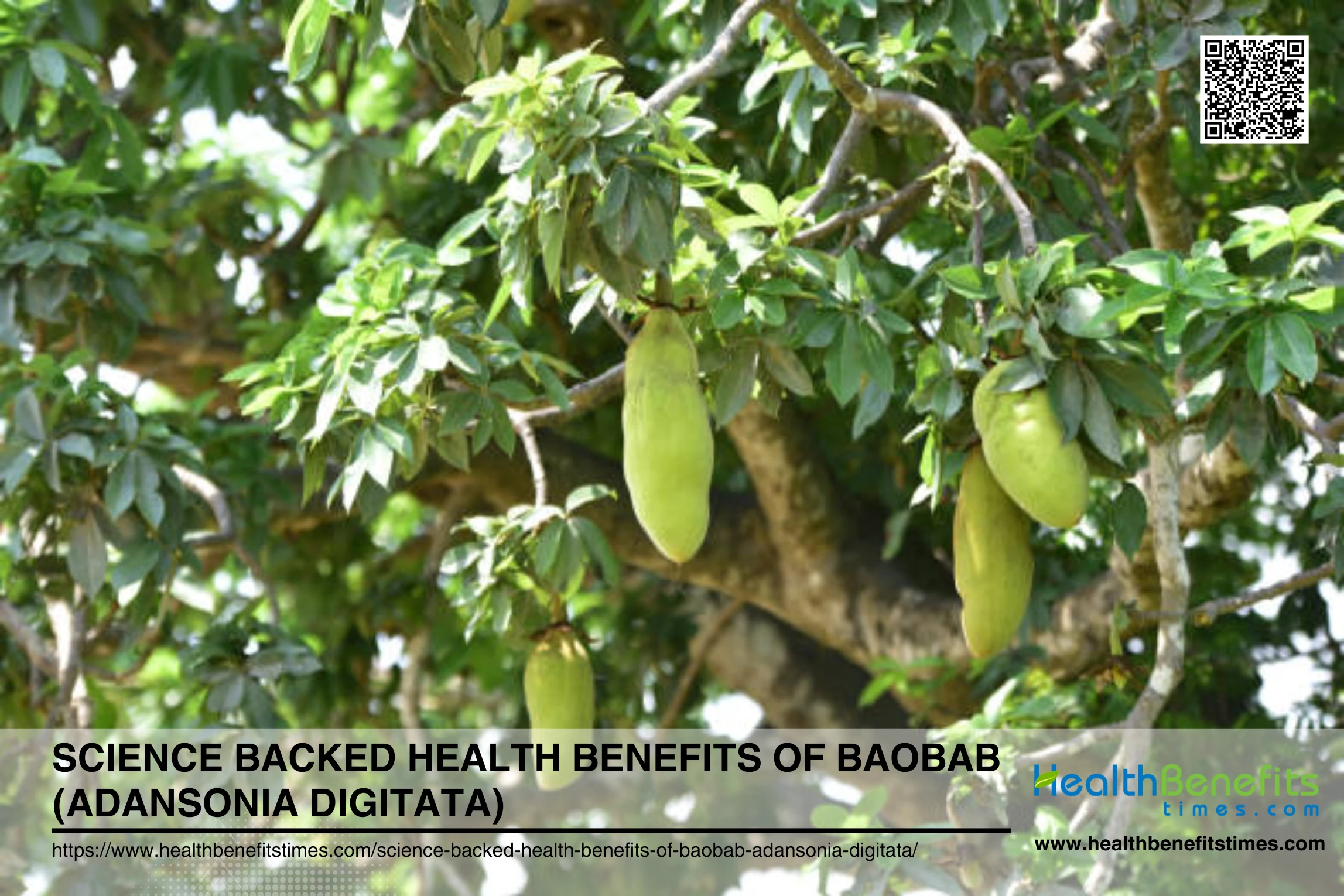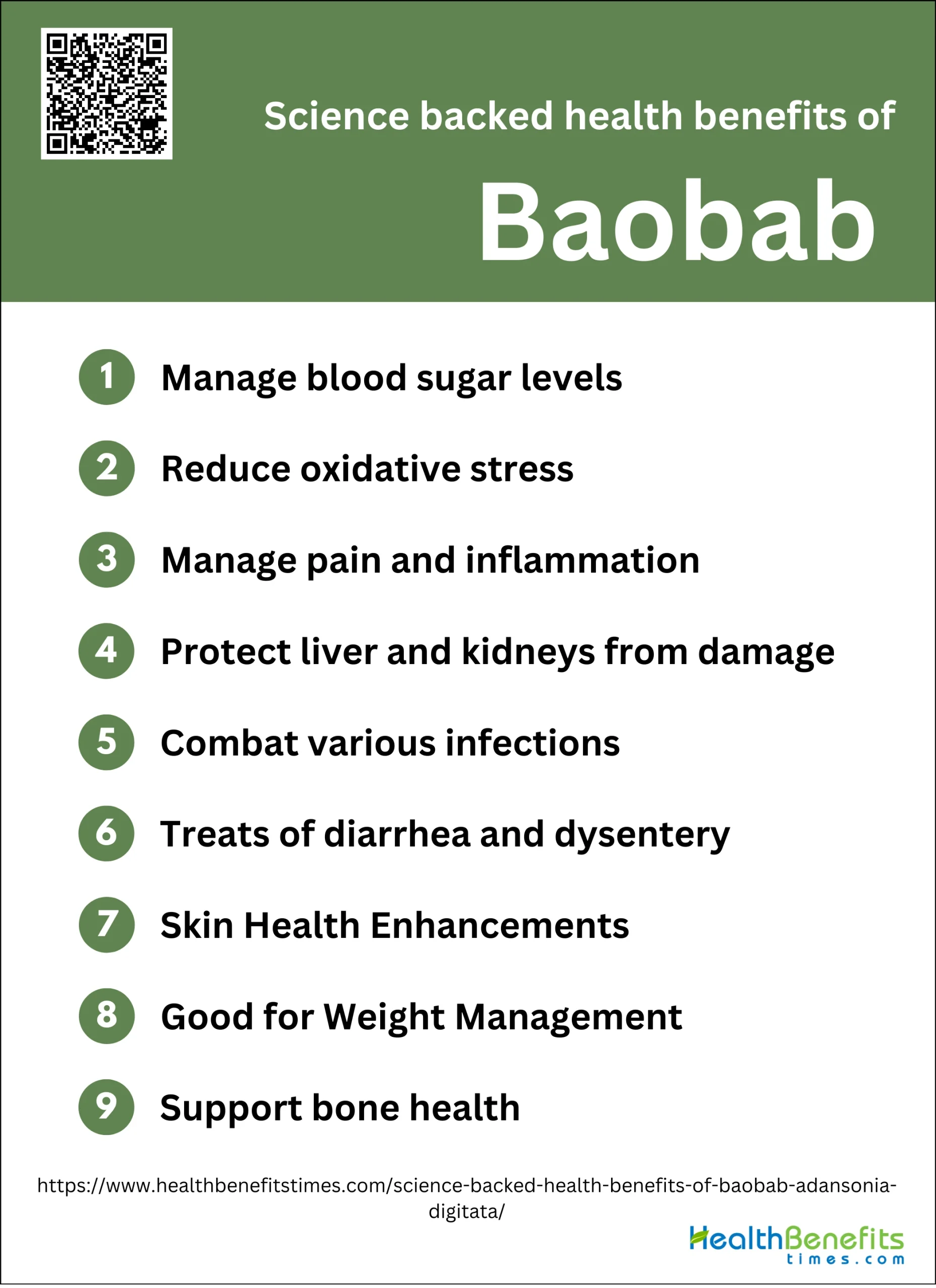- Baobab is an iconic African tree; provides food, medicine, nutrients, antioxidants, and fiber.
- Baobab is a new superfruit with benefits like blood sugar control, reduced inflammation.
- Baobab protects liver and kidneys, reduces damage from oxidative stress.
- Baobab improves skin health, rich in vitamins, antioxidants, hydration, anti-inflammatory properties.
- Baobab superfood is rich in nutrients, supports immunity, digestion, reduces inflammation.
- Baobab is safe but may cause digestive issues and medication interactions.
 Baobab, scientifically known as Adansonia digitata, is a remarkable tree native to Africa, Australia, and the Middle East, often referred to as the “Tree of Life” due to its myriad of uses and impressive longevity. The fruit of the baobab tree, which is typically consumed in powdered form, is gaining recognition for its exceptional nutrient profile and numerous health benefits. Rich in vitamin C, fiber, antioxidants, and essential minerals like potassium, magnesium, and iron, baobab has been linked to various health advantages. These include supporting digestive health, boosting the immune system, regulating blood sugar levels, and reducing inflammation. With its unique combination of nutrients and bioactive compounds, baobab stands out as a potent superfood backed by science, offering a natural way to enhance overall health and well-being.
Baobab, scientifically known as Adansonia digitata, is a remarkable tree native to Africa, Australia, and the Middle East, often referred to as the “Tree of Life” due to its myriad of uses and impressive longevity. The fruit of the baobab tree, which is typically consumed in powdered form, is gaining recognition for its exceptional nutrient profile and numerous health benefits. Rich in vitamin C, fiber, antioxidants, and essential minerals like potassium, magnesium, and iron, baobab has been linked to various health advantages. These include supporting digestive health, boosting the immune system, regulating blood sugar levels, and reducing inflammation. With its unique combination of nutrients and bioactive compounds, baobab stands out as a potent superfood backed by science, offering a natural way to enhance overall health and well-being.
What is Baobab ?
The African baobab is a remarkable and iconic tree species native to the African continent. This majestic tree is known for its impressive size, longevity, and multipurpose utility, providing food, medicine, and raw materials for various uses. Baobab trees are found across most of tropical Africa, with some populations extending to southern Arabia and several islands in the Atlantic and Indian Oceans, including Madagascar. The baobab is tetraploid, with a revised chromosome number of 2n = 4x = 168, and exhibits significant genetic diversity across its range. Its fruit pulp is rich in vitamin C, calcium, and other essential nutrients, making it valuable for nutritional and medicinal purposes. The tree’s various parts, including seeds, leaves, and bark, have been studied for their antimicrobial, anti-inflammatory, and antioxidant properties. Recent genomic studies have provided insights into its genetic makeup, aiding in conservation and domestication efforts. Overall, the baobab is not only a vital resource for local communities but also a subject of significant scientific interest due to its unique genetic and morphological characteristics.
Nutritional Profile of Baobab
Baobab is a nutrient-dense superfood that offers an impressive array of essential vitamins, minerals, and bioactive compounds. The fruit pulp, which is typically consumed in powdered form, contains a remarkable concentration of vitamin C, providing up to 10 times more than oranges by weight. This exceptional nutritional profile makes baobab a valuable addition to diets worldwide, offering potential benefits for overall health and well-being.
Vitamins and Minerals:
Baobab stands out for its exceptional vitamin C content, with levels reaching up to 280-300 mg per 100 grams of fruit pulp, significantly surpassing that of oranges. This high vitamin C concentration contributes to its immune-boosting properties and potential to fight off diseases. Additionally, baobab is a rich source of essential minerals, including calcium, potassium, magnesium, and iron. These minerals play crucial roles in various bodily functions, from bone health to muscle contraction and blood formation.
High Vitamin C content:
The vitamin C content in baobab fruit is truly remarkable, with levels up to 10 times higher than those found in oranges. This exceptional concentration makes baobab one of the most potent natural sources of vitamin C available. A single 10-gram serving of baobab powder can provide up to 33% of the daily recommended intake of vitamin C, highlighting its potential as a powerful dietary supplement for supporting immune function and overall health.
Rich in calcium, potassium, magnesium, and iron:
Baobab fruit pulp and leaves are excellent sources of essential minerals. The pulp is particularly rich in potassium, with levels significantly higher than those found in common fruits like bananas and apples. Calcium content in baobab leaves is noteworthy, often surpassing that of milk. Magnesium and iron are also present in substantial amounts, contributing to the fruit’s potential in addressing mineral deficiencies and supporting various physiological processes.
Macronutrients:
Baobab fruit pulp is a good source of macronutrients, particularly carbohydrates and dietary fiber. The carbohydrate content provides energy, while the high fiber content contributes to digestive health and may aid in weight management. Although lower in protein compared to other nutrients, baobab still offers a modest amount of this essential macronutrient, particularly in its leaves.
Fiber content:
One of baobab’s most notable nutritional attributes is its high fiber content. The fruit pulp contains nearly 50% fiber, making it an excellent source of both soluble and insoluble fiber. This significant fiber content contributes to digestive health, helps regulate blood sugar levels, and may promote feelings of fullness, potentially aiding in weight management efforts.
Protein and healthy fats:
While baobab fruit pulp is not particularly high in protein or fat, other parts of the plant offer these macronutrients. The leaves are a good source of high-quality protein, containing essential amino acids. The seeds, when processed, yield an oil rich in healthy fats, including omega-3 fatty acids. These components contribute to the overall nutritional value of the baobab plant, offering a more complete nutritional profile when various parts are consumed.
Antioxidants:
Baobab is renowned for its high antioxidant content, with some studies suggesting it has the highest antioxidant content of any fruit. The fruit pulp is rich in polyphenols and flavonoids, powerful antioxidants that help protect cells from oxidative stress and reduce inflammation in the body. These compounds contribute to baobab’s potential health benefits, including its anti-inflammatory and immune-boosting properties.
Presence of polyphenols and flavonoids:
The antioxidant profile of baobab is dominated by polyphenols and flavonoids, which are known for their potent free radical scavenging abilities. These compounds play a crucial role in protecting cells from oxidative damage and may help reduce the risk of chronic diseases. The presence of these bioactive compounds contributes significantly to baobab’s status as a superfood and its potential applications in both nutritional and medicinal contexts
Science backed health benefits of Baobab
Move over acai and goji berries – there’s a new superfruit in town, and it’s been hiding in plain sight for centuries. Baobab, the fruit of Africa’s iconic “Tree of Life,” is not just a cultural icon but a nutritional powerhouse backed by modern science. From boosting your immune system to promoting glowing skin, this ancient fruit is making waves in the health and wellness world. Let’s dive into the top 10 science-backed health benefits of baobab that will have you reaching for this nutrient-dense superfood in no time.
1. Manage blood sugar levels
Baobab has shown promising potential in managing blood sugar levels, according to several scientific studies. Consuming baobab fruit powder can significantly reduce the glycemic response when added to white bread or mixed with water. The fruit’s high content of soluble fiber (34%) and polyphenols appears to slow down the release of sugars from carbohydrates into the bloodstream, helping to prevent sugar spikes. Baobab fruit extract could lower both the incremental area under the curve (AUCi) of glucose response and the total insulin response in healthy participants. The potential blood sugar-regulating effect of baobab is attributed to its rich polyphenol content, particularly procyanidins, which may activate insulin signaling pathways.
What Research Says?
- Eating baobab fruit extract can lower blood sugar levels after meals in healthy and non-diabetic adults. This is because it has a lot of polyphenols and antioxidants.
- The fruit extract lowers blood sugar spikes after eating a meal high in carbs, like white bread. It works by slowing down how fast starch breaks down and sugar gets released.
- Baobab fruit pulp helps diabetic rats manage sugar and fat in their bodies. It lowers blood sugar levels and protects the pancreas.
- The fruit helps with diabetes because it lowers swelling in the body. This was shown when diabetic rats had lower levels of things that cause swelling, like TNF-α and IL-6.
- Baobab helps lower blood sugar by blocking enzymes that break down carbs. It also affects how the body handles fats.
2. Reduce oxidative stress
Baobab has demonstrated significant potential in reducing oxidative stress, thanks to its rich profile of bioactive compounds and antioxidants. Fruit’s impressive antioxidant capacity, which is attributed to its high content of vitamin C, polyphenols, and flavonoids. Baobab fruit pulp extracts possess strong free radical scavenging abilities against both reactive oxygen species (ROS) and reactive nitrogen species (RNS), with particularly potent effects against nitric oxide (•NO) and peroxynitrite (ONOO−). Baobab fruit pulp extract has been found to ameliorate oxidative stress induced by high-fat diets and protect against cellular injury in mice bearing Ehrlich Ascites Carcinoma (EAC). The fruit’s antioxidant properties have been linked to its ability to increase the activity of antioxidant enzymes such as catalase, superoxide dismutase, and glutathione peroxidase, while also boosting levels of reduced glutathione.
What Research Says?
- Baobab fruit pulp has a lot of phenolic compounds. These include proanthocyanidins, phenolic acids, flavonols, and saponins. They are closely linked to its strong antioxidant power.
- The fruit pulp is rich in vitamin C. It has about ten times more than oranges, which makes it a strong antioxidant.
- Baobab has healthy parts like phenols, flavonoids, and tannins. These help it act as an antioxidant, reduce swelling, ease pain, and fight germs.
3. Manage pain and inflammation

Baobab has been traditionally used to manage pain and inflammation, and modern research supports these uses. The plant’s various parts, including the leaves, fruit pulp, and bark, contain bioactive compounds such as flavonoids, tannins, and polyphenols, which exhibit significant anti-inflammatory and analgesic properties. Baobab extracts can inhibit the production of pro-inflammatory cytokines and enzymes like cyclooxygenase (COX), which play a key role in the inflammatory process. For instance, baobab bark extract significantly reduced pain responses in rats, comparable to the effects of standard anti-inflammatory drugs like indomethacin. Additionally, baobab’s high antioxidant content helps mitigate oxidative stress, further contributing to its anti-inflammatory effects.
What Research Says?
- Baobab has strong anti-inflammatory powers. This is because it’s full of vitamin C, flavonoids, and other plant chemicals.
- Baobab fruit pulp has things like hydroxycinnamic acid glycosides, iridoid glycosides, and phenylethanoid glycosides. These are tied to its ability to reduce inflammation and pain.
4. Protect liver and kidneys from damage
The methanol extract of baobab fruit pulp exhibits potent hepatoprotective activity, effectively mitigating liver damage induced by acetaminophen in rats by reducing oxidative stress and normalizing liver enzyme levels such as ALT, AST, and ALP. Additionally, baobab’s aqueous fruit pulp extract has been found to protect against lead-acetate-induced hepato-renal damage, highlighting its role in preventing oxidative damage and maintaining the integrity of liver and kidney tissues.
What Research Says?
- Baobab fruit helps protect the liver and kidneys in diabetic rats. It lessens problems caused by diabetes.
- In rabbits that had cadmium, baobab helped fix liver and kidney harm. It kept normal fat levels in the body and stopped damage to organs.
- Baobab fruit has lots of antioxidants and polyphenols. These help protect the liver and kidneys by cutting down on oxidative stress and inflammation.
- Baobab is full of nutrients like vitamins, minerals, and active compounds. These help keep you healthy and may protect your liver and kidneys.
5. Combat various infections
Baobab is renowned for its potent antimicrobial properties, making it effective in combating various infections. The tree’s different parts, including the leaves, bark, seeds, and fruit pulp, have been traditionally used to treat a range of ailments. Baobab exhibits significant antibacterial activity against pathogens such as Escherichia coli, Staphylococcus aureus, and Salmonella typhi. Additionally, its antiviral and anti-inflammatory properties further enhance its ability to fight infections. The high content of vitamin C, antioxidants, and polyphenols in baobab contributes to its immune-boosting effects, helping the body resist infections and promote overall health.
What Research Says?
- Baobab fruit extract and essential oil greatly stop the growth and toxin-making of fungi like Aspergillus flavus and Aspergillus parasiticus. They show powerful antifungal qualities.
- The ethylacetate part of baobab fruit pulp has substances that fight bacteria well. It works especially against Pseudomonas aeruginosa. This supports its traditional use for treating bladder infections.
- Baobab fruit is rich in antioxidants. It has been found to lower blood sugar levels in diabetic rats, showing it might help with diabetes.
6. Treats of diarrhea and dysentery

The fruit pulp, seeds, and leaves of the baobab tree are often prepared in various forms, such as aqueous extracts or decoctions, to provide oral hydration and alleviate gastrointestinal issues. The soluble fibers in baobab help to absorb excess water in the intestines, thus reducing diarrhea, while its antimicrobial properties combat the pathogens responsible for dysentery. Additionally, the high levels of vitamin C, polyphenols, and other antioxidants in baobab enhance its anti-inflammatory effects, promoting quicker recovery from these digestive ailments.
What Research Says?
- Baobab fruit pulp (BFP) and the shell (BFS) have healthy compounds like quercetin and proanthocyanidins. They stay stable and work well after digestion, helping with digestive health.
- Baobab fruit extract slows down starch digestion and lowers blood sugar spikes in people. This helps control blood sugar levels and boosts metabolic health.
- Baobab fruit has lots of vitamins, especially vitamin C. It also has minerals and active parts like phenols, flavonoids, and tannins. These help it act as an antioxidant and fight swelling and germs. They’re good for your digestion and can help with problems like diarrhea and dysentery.
- Studies show that baobab fruit has many healthful compounds. It can reduce blood sugar levels when fasting. It also protects the liver and kidneys. This is good for treating diabetes and its digestive problems.
7. Skin Health Enhancements
Baobab offers remarkable benefits for enhancing skin health, thanks to its rich nutrient profile and potent antioxidant properties. The oil extracted from baobab seeds is particularly beneficial, containing high levels of vitamins A, D, E, and K, as well as omega-3, -6, and -9 fatty acids. These components work synergistically to nourish and protect the skin, promoting a healthy skin barrier and preserving collagen. Baobab oil’s antioxidant content, including vitamin C, helps neutralize free radicals and reduce oxidative stress, which can slow down the signs of aging. Additionally, its moisturizing properties help hydrate the skin without leaving a greasy residue, making it suitable for various skin types. The oil’s anti-inflammatory properties can soothe irritated skin, potentially benefiting conditions like rosacea, eczema, and psoriasis. Furthermore, baobab oil has been shown to improve skin elasticity, reduce the appearance of fine lines and wrinkles, and promote overall skin radiance. With its multifaceted approach to skin health, baobab oil has become an increasingly popular ingredient in skincare products, offering a natural and effective solution for maintaining healthy, youthful-looking skin.
What Research Says?
- Baobab fruit pulp and leaves have a lot of phenolic compounds. These include procyanidins and flavonol glycosides, which are powerful antioxidants.
- Baobab is full of antioxidants because it has a lot of vitamin C, flavonoids, and polyphenols. These help fight off free radicals and keep skin cells safe from damage.
8. Good for Weight Management
Baobab is highly beneficial for weight management due to its rich fiber content and various bioactive compounds. The high levels of dietary fiber in baobab promote feelings of fullness and satiety, which can help reduce overall calorie intake and curb cravings. Additionally, baobab has a low glycemic index, meaning it helps regulate blood sugar levels and prevent spikes and crashes that can lead to overeating. The fruit’s polyphenols and antioxidants also support metabolic health by reducing inflammation and oxidative stress, further aiding in weight management. By incorporating baobab powder into a balanced diet, individuals can leverage these properties to support their weight loss and maintenance goals effectively.
What Research Says?
- Baobab fruit has lots of vitamins, minerals, and healthy plant chemicals. These give it its health benefits.
- Baobab fruit extract helps slow down starch digestion and control blood sugar in people. This can help with weight management.
- Studies in living organisms showed that eating baobab fruit reduced blood sugar levels when fasting. It also protected the liver and kidneys in diabetic models.
9. Support bone health

Baobab plays a significant role in supporting bone health due to its impressive nutrient profile, particularly its high calcium content. The fruit pulp of baobab is exceptionally rich in calcium, containing more than twice the amount found in milk. This high calcium concentration is crucial for building and maintaining strong bones and teeth, as well as supporting muscle function. Additionally, baobab leaves also contain substantial levels of calcium, further contributing to its bone-strengthening properties. The fruit’s magnesium content is also noteworthy, as it works synergistically with calcium to promote optimal bone health. Moreover, baobab is a good source of phosphorus, another essential mineral for bone and teeth maintenance. The combination of these minerals, along with other nutrients like vitamin C, which aids in collagen formation, makes baobab an excellent natural supplement for supporting overall bone health and potentially preventing conditions like osteoporosis.
What Research Says?
- Baobab fruit and seeds have a lot of calcium, important for strong bones. Research shows that baobab pulp from Malawi has a high amount of calcium (4,300 mg/kg).
- Baobab fruit and seeds have a lot of calcium, important for strong bones. Research shows that baobab pulp from Malawi has a high amount of calcium (4,300 mg/kg).
Incorporating Baobab into Your Diet
Baobab fruit, often referred to as a superfood, is packed with essential nutrients like vitamin C, antioxidants, fiber, calcium, potassium, and magnesium. Adding baobab to your diet can significantly boost your nutrient intake, support immune function, and improve digestive health. Its high fiber content aids in digestion, while its antioxidants help combat oxidative stress and inflammation. Whether in powder form, oil, or as part of a supplement, baobab can easily be integrated into various meals and snacks, providing a natural and nutritious boost to your daily diet.
Forms of Baobab Available
Baobab is available in several forms, each offering unique benefits and uses:
- Powder: Made from the dried pulp of the baobab fruit, it is rich in vitamins and minerals and can be added to smoothies, juices, and baked goods.
- Oil: Extracted from baobab seeds, this oil is commonly used in skincare for its moisturizing and antioxidant properties.
- Fruit: The whole baobab fruit can be consumed directly, though it is less common outside regions where the tree grows.
- Supplements: Available in capsule or tablet form, these provide a convenient way to incorporate baobab’s benefits into your daily routine.
Practical Tips for Use
Baobab powder is incredibly versatile and can be easily incorporated into various recipes:
- Smoothies: Add a tablespoon of baobab powder to your favorite smoothie for a nutrient boost.
- Baking: Mix baobab powder into the batter for cakes, muffins, or bread to enhance their nutritional value.
- Yogurt and Oatmeal: Sprinkle baobab powder over yogurt or oatmeal for a tangy, nutritious addition.
- Juices and Water: Stir baobab powder into fruit juices or water for a refreshing drink.
Recipes and Serving Suggestions
Here are a couple of simple recipes to get you started with baobab:
- Baobab Smoothie: Blend together one banana, a handful of berries, one tablespoon of baobab powder, one cup of almond milk, and a handful of spinach for a delicious and nutritious smoothie.
- Baobab Energy Balls: Combine dates, nuts, one tablespoon of baobab powder, and one tablespoon of nut butter in a food processor. Roll the mixture into small balls and refrigerate for a healthy snack.
Recommended Daily Intake
The recommended daily intake of baobab powder varies, but a common suggestion is 10-20 grams per day, which is roughly one to two tablespoons. This amount is sufficient to provide significant health benefits without causing adverse effects. However, it’s essential to start with a smaller amount and gradually increase it to avoid digestive discomfort due to its high fiber content. Always consult with a healthcare provider before adding new supplements to your diet, especially if you have underlying health conditions or are on medication
Potential Side Effects and Considerations
While baobab is generally considered safe for most people when consumed in moderate amounts, it’s important to be aware of potential side effects and considerations. As with any dietary supplement or new food, individual reactions can vary. Some people may experience mild digestive issues like bloating or gas, especially when first introducing baobab into their diet or consuming large quantities. It’s always advisable to start with small amounts and gradually increase intake to assess your body’s response.
Possible Side Effects
The most commonly reported side effects of baobab consumption are related to digestive discomfort. Due to its high fiber content, some individuals may experience bloating, gas, or diarrhea, particularly if they consume large amounts or are not accustomed to high-fiber foods. Allergic reactions, while rare, are possible and may manifest as itching, swelling, hives, or in severe cases, anaphylaxis. It’s worth noting that these side effects are generally mild and uncommon, with most people tolerating baobab well when consumed in recommended amounts.
Who Should Avoid Baobab
Certain groups should exercise caution or avoid baobab altogether. Pregnant and breastfeeding women should consult with their healthcare provider before consuming baobab, as there isn’t enough reliable information about its safety in these conditions. Individuals with known allergies to fruits or plants in the Malvaceae family (e.g., kiwi or mango) may be at higher risk of allergic reactions to baobab. People with diabetes or those taking medications to regulate blood sugar should monitor their levels closely, as baobab may affect blood glucose levels. Additionally, those with digestive sensitivities or conditions may want to introduce baobab gradually to their diet to minimize potential gastrointestinal discomfort.
Interactions with Medications
Baobab may interact with certain medications, potentially affecting their efficacy or increasing the risk of side effects. Due to its high vitamin C and iron content, baobab could enhance iron absorption, which may be a concern for individuals with iron overload disorders or those taking iron supplements. The fruit’s potential to lower blood sugar levels could interact with diabetes medications, possibly leading to hypoglycemia if not properly monitored. Additionally, the high fiber content of baobab may interfere with the absorption of some medications. As a precaution, it’s advisable to take medications at least 2 hours before or after consuming baobab products. Always consult with a healthcare provider before adding baobab to your diet if you’re taking any medications, especially those for diabetes, blood pressure, or anticoagulants.
Conclusion
In conclusion, baobab emerges as a remarkable superfood with a wide array of science-backed health benefits. From managing blood sugar levels and reducing oxidative stress to supporting bone health and enhancing skin condition, baobab’s nutrient-dense profile makes it a valuable addition to a healthy diet. Its high content of vitamin C, antioxidants, fiber, and essential minerals contributes to its ability to combat infections, aid in weight management, and promote overall well-being. While generally safe for consumption, it’s important to introduce baobab gradually and be aware of potential interactions with medications. As research continues to unveil its potential, baobab stands out as a versatile and powerful natural supplement that can be easily incorporated into various recipes and daily routines, offering a natural boost to nutrition and health.
ADDITIONAL RESOURCES
Here is a list of US organizations related to research on vegetables, along with their short descriptions and URLs:
1. University of California Agriculture and Natural Resources (UC ANR)
UC ANR conducts research and extension activities on various vegetable crops, aiming to improve production practices, pest management, and crop quality. Their work supports both commercial growers and home gardeners.
Recommendations for books on Baobab
Here are some recommendations for books on research about Baobab, including their links:
1. “The Baobabs: Pachycauls of Africa, Madagascar and Australia” by Gerald E. Wickens and Pat Lowe
This book provides comprehensive information about the biology, ecology, and ethnobotany of baobabs. It covers various species found in Africa, Madagascar, and Australia.
2. “The African Baobab” by Rupert Watson
This book explores the significance of the African baobab tree in different cultures and its various uses. It delves into the tree’s ecology and the myths and legends surrounding it.
3. “The Remarkable Baobab” by Thomas Pakenham
This book provides an in-depth look at the baobab tree, including its natural history, cultural importance, and uses. The author combines scientific research with personal anecdotes and stunning photography.
4. “Adansonia Digitata: A Review of Traditional Uses, Phytochemistry and Pharmacology” by Mukeshwar Pandey (Editor)
This book is a comprehensive review of the traditional uses, phytochemistry, and pharmacology of Adansonia digitata, commonly known as the baobab. It covers its medicinal properties and potential health benefits.
5. “Baobab: The Tree of Life” by John Rashford (Editor)
This edited volume brings together various research studies on the baobab tree, focusing on its ecological significance, cultural importance, and potential for sustainable development.
FAQS
- What are the main nutritional components of baobab fruit?
Baobab fruit is rich in vitamin C, fiber, antioxidants, potassium, magnesium, and calcium. It contains six times more vitamin C than oranges and has a high antioxidant content. - How does baobab support digestive health?
Baobab is high in dietary fiber, which aids digestion, promotes regular bowel movements, and supports the growth of beneficial gut bacteria. It acts as a prebiotic, feeding the good bacteria in your gut. - Can baobab help regulate blood sugar levels?
Yes, studies have shown that baobab can help manage blood sugar levels. Its high fiber content slows down the absorption of sugar into the bloodstream, potentially preventing spikes in blood glucose. - What are the skin benefits of baobab?
Baobab’s high vitamin C content supports collagen production, which can help improve skin elasticity and reduce the appearance of wrinkles. Its antioxidants also protect the skin from oxidative damage. - How does baobab support the immune system?
The high vitamin C content in baobab helps boost the immune system by supporting various cellular functions of both the innate and adaptive immune system. - Can baobab aid in weight management?
Baobab’s high fiber content can promote feelings of fullness, potentially reducing overall calorie intake. Some studies suggest it may help curb cravings and support weight loss efforts. - Does baobab have anti-inflammatory properties?
Yes, baobab contains polyphenols and other compounds with anti-inflammatory properties. While more human studies are needed, animal research has shown promising results in reducing inflammation. - How does baobab support heart health?
Baobab’s potassium content may help regulate blood pressure, while its antioxidants can support overall cardiovascular health by reducing oxidative stress. - Can baobab improve iron absorption?
Yes, the high vitamin C content in baobab can enhance the absorption of non-heme (plant-based) iron, potentially benefiting those at risk of iron deficiency. - Are there any potential side effects or precautions when consuming baobab?
While baobab is generally considered safe when consumed in food amounts, there’s limited research on its safety as a supplement. Pregnant or breastfeeding women should consult a healthcare provider before using baobab supplements.


